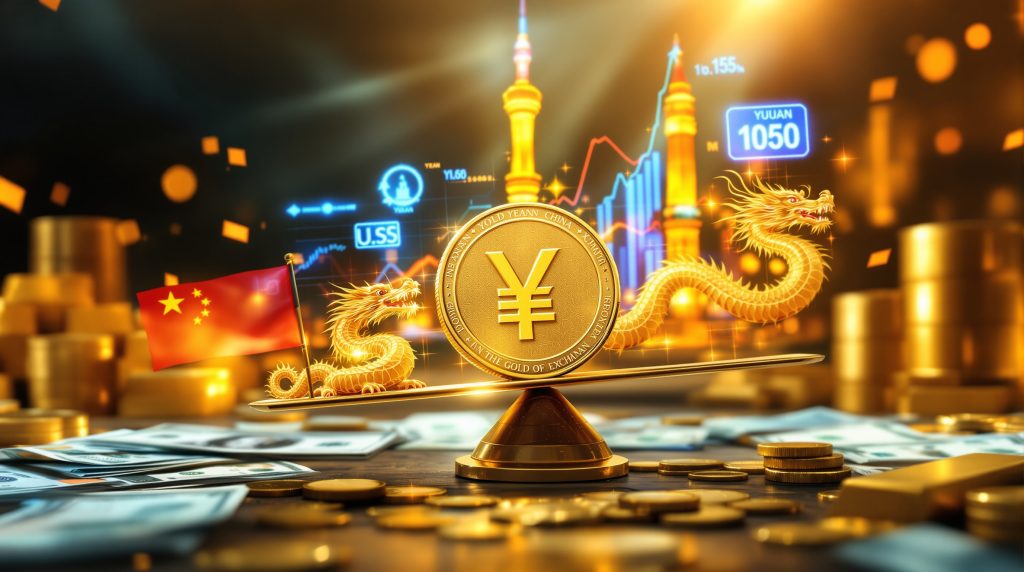What Is a Gold-Backed Yuan?
A gold-backed yuan refers to China's strategic initiative to link its currency (renminbi/yuan) to physical gold reserves. Unlike a traditional gold standard where currency can be directly exchanged for gold at fixed rates, China's approach represents a more nuanced strategy combining physical gold holdings, trade settlement mechanisms, and financial infrastructure to enhance the yuan's international credibility and usage.
This strategy involves establishing gold-backed trade settlement options, expanding gold trading platforms, and gradually positioning the yuan as an alternative to the US dollar in international transactions. By associating its currency with gold—historically viewed as the ultimate form of money—China aims to address concerns about fiat currency stability while building trust in the yuan among global trading partners.
Why Is China Pursuing a Gold-Backed Yuan?
Reducing Dollar Dependency
China's pursuit of a gold-backed yuan primarily aims to reduce its vulnerability to US dollar dominance. With approximately 60% of global foreign exchange reserves held in dollars and most international trade settled in the American currency, China faces significant exposure to US monetary policy decisions and potential sanctions.
By creating alternative settlement mechanisms backed by gold, China can offer trading partners—particularly those facing Western sanctions or seeking to diversify currency exposure—a more neutral option for conducting international business. This strategy directly addresses concerns about US dollar weaponization through financial sanctions and restrictions.
Enhancing Yuan Internationalization
Despite being the world's second-largest economy, China's currency accounts for only about 3% of global payments and 2.7% of global reserves—significantly below its economic footprint. A gold connection potentially accelerates yuan internationalization by:
- Building confidence in the yuan's long-term stability
- Creating tangible asset backing that appeals to central banks and investors
- Establishing alternative financial infrastructure for trade settlement
- Providing a competitive advantage over other emerging market currencies
Financial analysts estimate that gold backing could accelerate yuan internationalization by 10-20 years compared to conventional approaches.
Protecting Against Inflation and Currency Devaluation
Gold has historically served as a hedge against inflation and currency devaluation. By increasing its official gold reserves and establishing gold-backed financial instruments, China creates a perception of greater monetary stability compared to purely fiat currencies.
This approach addresses concerns about potential yuan devaluation, especially as China navigates complex economic transitions and manages its significant debt levels. The gold prices analysis signals to markets that China has substantial real assets backing its financial system.
How Is China Building a Gold-Backed Yuan System?
Strategic Gold Acquisition
China has dramatically increased its gold holdings through both domestic production and international purchases:
| Activity | Details | Significance |
|---|---|---|
| Domestic Mining | China ranks as the world's largest gold producer (over 370 tonnes annually) | Creates domestic supply chain control |
| Official Reserves | Central bank reported holdings exceed 2,200 tonnes | Provides official backing for currency |
| Unofficial Holdings | Estimated additional 3,000-5,000 tonnes in sovereign wealth funds and state entities | Creates strategic reserves beyond official reporting |
| Import Acceleration | Record imports exceeding 900 tonnes in early 2025 | Demonstrates accelerating accumulation strategy |
Unlike Western central banks that typically report all gold holdings transparently, China maintains significant "off-balance sheet" gold reserves through sovereign wealth funds and state-owned enterprises, creating strategic flexibility.
Shanghai Gold Exchange Expansion
The Shanghai Gold Exchange (SGE) serves as the cornerstone of China's gold-backed yuan infrastructure:
- Established in 2002 and now handles the world's largest physical gold trading volume
- Operates on a "physical delivery" model rather than the paper contracts common in Western markets
- Recently opened membership to foreign institutions without requiring Chinese subsidiaries
- Expanded with international vaults in Hong Kong, Singapore, and Dubai
- Launched yuan-denominated gold benchmarks to compete with London fixing
This infrastructure allows for seamless conversion between yuan and physical gold, creating the foundation for gold-backed trade settlement.
Digital Yuan Integration with Gold Systems
China's digital yuan (e-CNY) project includes capabilities specifically designed to interface with gold-backed systems:
- Smart contract functionality that can reference gold prices and holdings
- Cross-border payment channels that support gold-backed settlement options
- Integration with blockchain systems for tracking gold ownership and transfers
- Compatibility with BRICS payment infrastructure for multi-currency settlement
These technological foundations create the infrastructure needed for a modern, digitally-enabled gold-backed currency system that avoids the limitations of historical gold standards.
How Would Gold-Backed Yuan Trade Settlement Work?
The Basic Mechanics
Gold-backed yuan trade settlement offers an alternative to dollar-based systems through several mechanisms:
-
Direct Gold Settlement: Trading partners can settle imbalances with physical gold transfers through the Shanghai Gold Exchange or partner vaults.
-
Yuan-Gold Convertibility: Foreign holders of yuan can convert their holdings to physical gold at designated exchange points, creating confidence in the currency's value.
-
Gold-Backed Trade Notes: Special financial instruments denominated in yuan but backed by gold reserves serve as trade settlement vehicles.
-
Commodity-Linked Contracts: Yuan-denominated commodity contracts (especially oil) with gold convertibility options create natural demand for the currency.
These mechanisms don't require a formal "gold standard" but instead create practical pathways for gold to function as the ultimate settlement asset within the yuan ecosystem.
Oil-Gold-Yuan Triangle
A particularly significant application involves China's creation of yuan-denominated oil contracts convertible to gold:
- The Shanghai International Energy Exchange launched crude oil futures contracts denominated in yuan
- These contracts include options for settlement in physical gold through the Shanghai Gold Exchange
- Major oil producers like Russia, Iran, and Saudi Arabia have begun accepting yuan for oil shipments
- This creates a "petro-yuan" alternative to the traditional "petrodollar" system
This triangular relationship between oil, gold, and yuan creates a powerful mechanism for increasing yuan usage in international trade while leveraging China's position as the world's largest oil importer.
What Are the Advantages of a Gold-Backed Yuan?
For China
The gold-backed yuan strategy offers China several strategic advantages:
- Sanction Resistance: Creates payment channels immune to US financial system restrictions
- Monetary Sovereignty: Reduces vulnerability to Federal Reserve policy decisions
- Financial Influence: Expands China's role in global financial governance
- Resource Security: Facilitates direct resource acquisition without dollar intermediation
- Domestic Stability: Provides additional anchoring for domestic monetary policy
These advantages align with China's broader "dual circulation" economic strategy that emphasizes both domestic resilience and international engagement.
For Trading Partners
For China's trading partners, particularly those in the Global South and BRICS nations, a gold-backed yuan offers:
- Reduced Currency Risk: Less exposure to dollar volatility and US monetary policy
- Sanctions Protection: Alternative payment channels for countries facing Western restrictions
- Diversification: Option to reduce over-reliance on any single currency
- Simplified Settlement: Direct bilateral settlement without converting through dollars
- Lower Transaction Costs: Potential savings on currency conversion and compliance costs
These benefits explain why countries like Russia, Iran, Saudi Arabia, and Brazil have shown increasing interest in yuan-based trade settlement options.
What Are the Limitations and Challenges?
Limited Gold Reserves
Despite China's substantial gold holdings, they remain insufficient for comprehensive currency backing:
- China's estimated 5,000-7,000 tonnes of gold (including unofficial holdings) represents approximately $400-560 billion in value
- This covers only a fraction of China's $18 trillion economy and $3+ trillion in annual trade
- Full convertibility would require substantially larger reserves or a much higher gold price
This reality means China must pursue a partial or symbolic gold backing rather than full convertibility in the traditional sense.
Market Trust and Transparency
China faces significant transparency challenges that could limit international adoption:
- Opaque reporting of actual gold holdings creates uncertainty
- Questions about gold purity and auditing standards persist
- Government intervention in markets raises concerns about free convertibility
- Capital controls contradict the concept of a freely exchangeable gold-backed currency
These trust factors explain why China is pursuing a gradual, pragmatic approach rather than announcing a formal gold standard.
Technical Implementation Hurdles
Practical implementation of a gold-backed yuan system faces several technical challenges:
- Valuation Mechanism: Determining how yuan and gold values relate in a floating exchange rate environment
- Settlement Infrastructure: Building physical and digital systems for efficient gold transfers
- Regulatory Framework: Establishing rules for gold-backed financial instruments
- Market Liquidity: Ensuring sufficient depth in yuan-gold markets for large-scale trade
These technical considerations explain why China is building infrastructure gradually rather than making abrupt system changes.
How Does the Gold-Backed Yuan Fit into BRICS Strategy?
BRICS Currency Coordination
The gold-backed yuan initiative aligns with broader BRICS (Brazil, Russia, India, China, South Africa) efforts to create alternative financial arrangements:
- BRICS nations collectively hold approximately 5,000 tonnes of official gold reserves
- The group has discussed creating a commodity-backed settlement currency
- Member countries have established cross-currency swap arrangements to facilitate local currency trade
- The New Development Bank provides financial infrastructure for BRICS cooperation
China's gold-backed yuan could serve as a transitional step toward more comprehensive BRICS monetary cooperation, potentially evolving into a multi-currency basket with gold backing.
Digital Infrastructure Development
BRICS nations are collaboratively developing digital financial infrastructure that complements gold-backed settlement:
- Cross-border payment systems that bypass SWIFT
- Digital currency bridges between central banks
- Blockchain solutions for tracking gold and commodity movements
- Alternative credit rating and financial information services
This digital infrastructure creates the technical foundation for implementing gold-backed settlement mechanisms across the BRICS economic sphere.
What Are the Global Implications?
Impact on the US Dollar
A successful gold-backed yuan would have significant implications for the US dollar:
- Reserve Diversification: Central banks could accelerate shifts from dollars to yuan and gold
- Trade Settlement Shifts: Bilateral trade in yuan could reduce dollar transaction volumes
- Commodity Pricing: Key commodities might increasingly reference yuan prices alongside dollars
- Interest Rate Pressure: Reduced foreign demand for US Treasuries could impact borrowing costs
While an immediate dollar collapse is unlikely, the cumulative effect could be a gradual erosion of dollar primacy in specific trade corridors and reserve portfolios.
Potential for a New Monetary Order
The gold-backed yuan initiative represents part of a broader potential shift in the international monetary system:
- Movement toward a more multipolar currency regime with regional dominant currencies
- Renewed emphasis on commodity backing for international settlement
- Integration of digital and traditional currency systems
- Greater role for gold in international financial architecture
This evolution would represent the most significant change to the global monetary system since the end of the Bretton Woods gold exchange standard in 1971.
What Should Investors and Businesses Consider?
Portfolio Implications
For investors, China's gold-backed yuan strategy suggests several portfolio considerations:
- Physical Gold Exposure: Potential appreciation as monetary demand increases
- Mining Equities: Companies producing gold could benefit from higher demand
- Currency Diversification: Reducing exclusive dollar exposure in international portfolios
- Chinese Government Bonds: Potentially more attractive with implied gold connection
- Commodity Producers: Companies selling to China may benefit from simplified settlement
These considerations apply particularly to long-term strategic investors rather than short-term traders. The ongoing record-high gold prices reflect growing interest in gold as a strategic asset.
Business Strategy Adjustments
Businesses engaged in international trade should consider several strategic adjustments:
- Treasury Operations: Developing capacity to manage yuan-denominated transactions
- Banking Relationships: Establishing connections with banks offering yuan settlement
- Contractual Terms: Updating agreements to accommodate alternative settlement options
- Pricing Models: Preparing for potential shifts in commodity pricing benchmarks
- Compliance Systems: Understanding the evolving regulatory landscape for yuan transactions
Early preparation can position businesses to benefit from new opportunities while managing transition risks. The recent gold market surge demonstrates increasing institutional interest in gold-related financial instruments.
Conclusion
China's gold-backed yuan strategy represents a sophisticated, multi-faceted approach to increasing its currency's international role rather than a simple return to a traditional gold standard. By building physical gold reserves, establishing trading infrastructure, creating convertibility options, and developing digital capabilities, China is constructing a parallel financial system that offers alternatives to dollar dominance.
While significant challenges remain—including limited reserves, transparency concerns, and implementation hurdles—the initiative has already begun reshaping aspects of international trade and finance. The strategy's ultimate success will depend on China's ability to balance monetary sovereignty with the openness and transparency needed for international adoption.
For global investors, businesses, and policymakers, understanding the mechanics and implications of the gold-backed yuan initiative provides important context for navigating an evolving international monetary landscape where gold may once again play a more central role. Recent gold price forecast models suggest continuing upward momentum, particularly as central banks increase their gold holdings.
Further Exploration
Readers interested in learning more about the evolution of international monetary systems and gold's role in global finance can explore China's gold strategy challenging the US dollar's dominance. Additionally, exploring effective gold investment strategies can help investors position themselves appropriately in this changing landscape.
For a deeper understanding of the renminbi internationalization process, the BNP Paribas analysis on the petro-yuan and the role of gold provides valuable insights into China's long-term financial strategy.
Ready to Discover the Next Major Gold Opportunity?
Gain instant alerts on significant ASX mineral discoveries with Discovery Alert's proprietary Discovery IQ model, which transforms complex gold market data into actionable insights for investors. Visit our dedicated discoveries page to understand why historic discoveries can generate substantial returns and begin your 30-day free trial today.




